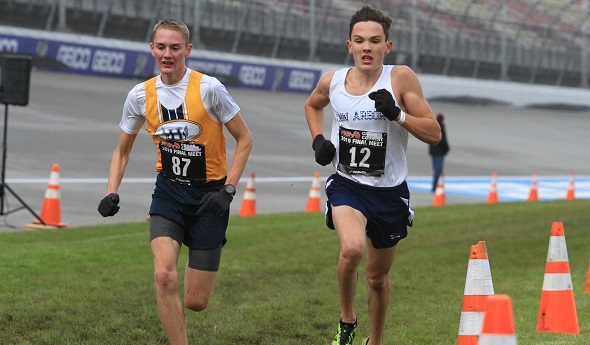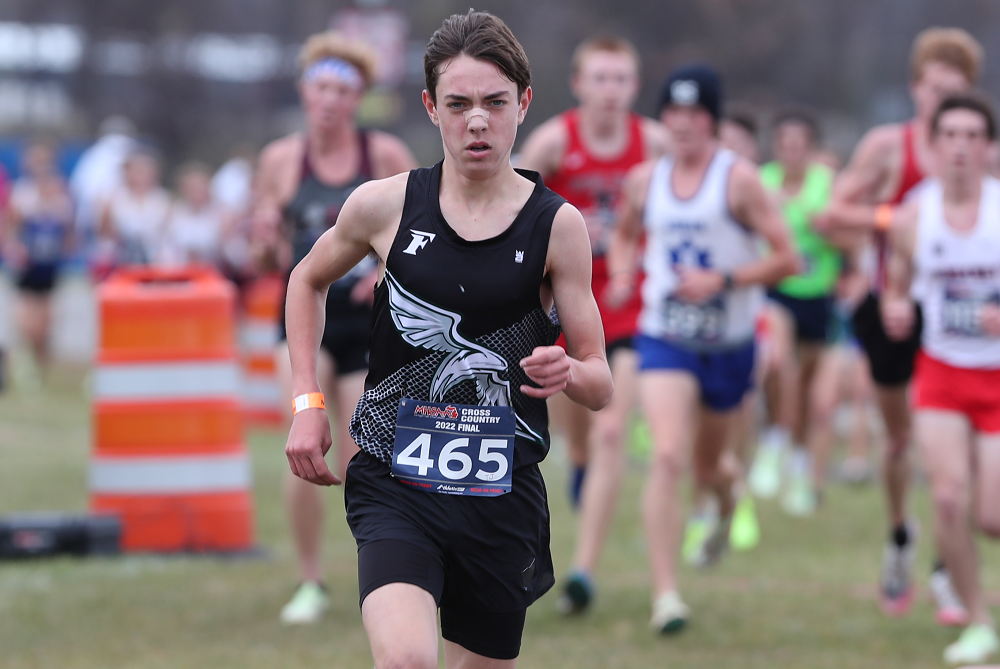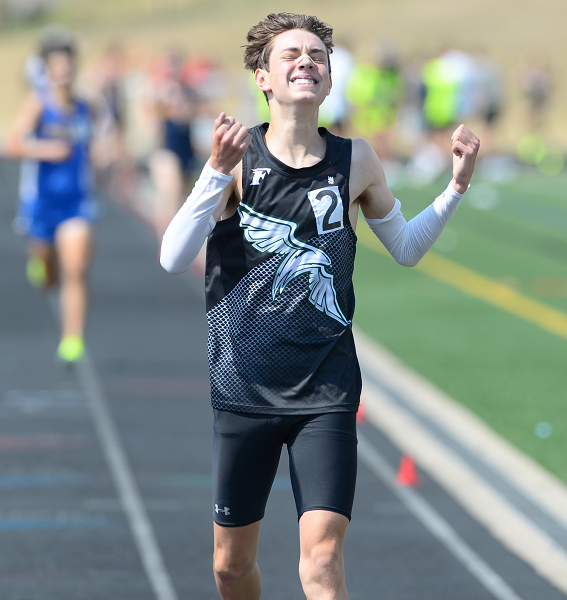
Preview: Forecast Calls for New Favorites
November 5, 2020
By Geoff Kimmerly
Second Half editor
With apologies to Division 2 favorite Fremont, this weekend’s Lower Peninsula Boys Cross Country Finals at Michigan International Speedway could be in store for wholesale changes atop the team standings.
Fremont is the only reigning champion or 2019 runner-up ranked among the top three in its division heading into this weekend’s championship races.
A change in format also will switch things up a bit. To limit the number of participants in each race, the four divisions will be run over two days – Friday and Saturday – with each gender in each division spread over two races. Third-place teams and individual qualifiers from Regionals will run first, and first and second-place Regional finishers will run second.
Watching this year’s Finals at MIS also will be different. Attendance is limited due to COVID-19 precautions, but opportunities to watch off-site are available again via MHSAA.tv. Coverage will be enhanced this year with an additional camera on the back of the course to better capture the first 800 meters, 1.5-mile and 2.25-mile marks of the race. The traditional Finish Line camera also will cover the action, with commentary from a crew of announcers.
Here’s the schedule, with links to broadcasts of each race:
Friday – Nov. 6
Division 1 Finals - Boys at 9:30 and 10 a.m. - Girls at 11 and 11:30 a.m.
Division 2 Finals - Boys at 1:30 and 2 p.m. - Girls at 3 and 3:30 p.m.
Saturday – Nov. 7
Division 3 Finals - Boys at 9:30 and 10 a.m. - Girls at 11 and 11:30 a.m.
Division 4 Finals - Boys at 1:30 and 2 p.m. - Girls at 3 and 3:30 p.m.
Come back both Friday and Saturday for coverage of all four meets on Second Half, and see below for teams and individuals who should be in the running. References to a list of fastest times per division this fall includes only the top time for each runner and can be found with the Finals program and much more information on or linked to MHSAA.com.
Division 1
Reigning champion: Brighton
2019 runner-up: Dexter
2020 top-ranked: 1. Romeo, 2. Caledonia, 3. Rockford
This season’s favorites are a mix of everything, with Romeo seeking its first championship, Caledonia its first since 1996 and Rockford a traditional power hoping to add a fifth championship with its most recent in 2014 and 2015. Romeo finished seventh last season and graduated four of its top seven, but the three runners back this weekend – seniors Zander Cobb and Joseph Rinke and junior Jack Kelke – are positioned to finished among the top 22 based on their fastest times this season. Caledonia is looking to jump from 10th last season returning its top four placers from that team and with senior Jamin Thompson and junior Josh Oom posting the 24th and 25th-fastest season bests in Division 1 this fall. Rockford did finish second to Caledonia in the Ottawa-Kent Conference Red championship race but might have the fastest individual of this bunch in senior Jude Parks, whose 15:30.88 is the eighth-fastest time in the division.
Individuals: Hartland senior Riley Hough finished seventh a year ago and has won all but one of his races this fall, with a 14:48.40 personal record that is the fastest time in Division 1. That one loss came in August against Ann Arbor Skyline to senior Hobbs Kessler, who finished sixth last season, has the division’s second-fastest time of 14:53.30 and is undefeated this fall. Traverse City Central senior Drew Seabase and Plymouth senior Patrick Byrnes rank third and fourth, respectively, for fastest times this season after finishing 17th and fifth at the 2019 Final. Jenison senior Connor Vachon (12th), Milford senior Kazuma Bowring (14th) and Farmington senior Peter Baracco (19th) also are back from last year’s top 20, and Richland Gull Lake senior Koby Fraaza was fifth in Division 2. Salem senior Talha Syed and Utica senior Carson Nicoletti have been among the fastest this fall and should be in the mix.
Division 2
Reigning champion: Fremont
2019 runner-up: Otsego
2020 top-ranked: 1. Fremont, 2. St. Johns, 3. Pinckney
Fremont broke Chelsea’s two-year hold on the Division 2 championship last season by finishing significantly ahead of the field and with only one senior. A year later, senior Nathan Walker will attempt to move up from fourth individually and has the fastest season-best time in Division 2 (14:56.46) by more than 34 seconds. The second-fastest time belongs to junior teammate Conor Somers (15:30.62), who was eighth at the 2019 Final, while now-seniors Adam Ward and Ben Paige also finished among the top 20. St. Johns has five of its seven back from last season’s eighth-place team, and they form an impressive pack – all five have season-best times between 15:56 and 16:31. The Redwings are seeking their first title. Pinckney, seeking its first since 2007, qualified two individuals for last year’s Division 1 Final, and senior Gavin White could make a move after coming in 20th in that field. His season best ranks seventh in Division 2 and junior teammate Caleb Jerema’s (15:32.30) ranks fourth.
Individuals: The Fremont crew makes up 40 percent of runners back from last season’s top 20, with Walker the highest-placing returnee and Somers second on the list. Otsego senior Colin Mulder was ninth last season and has the third-fastest time this fall (15:31.22), while St. Clair senior Jack Pennewell was 83rd a year ago but is unbeaten this season and has the fifth-fastest time (15:39.60). Ada Forest Hills Eastern senior Ben Clason (12th), Freeland sophomore Braydon Honsinger (13th), Holland Christian junior Parker Lambers (14th), Yale senior Matthew McClelland (15th) and Dearborn Divine Child sophomore Michael Hegarty (19th) also are back from the top 20.
Division 3
Reigning champion: Hanover-Horton
2019 runner-up: Grandville Calvin Christian
2020 top-ranked: 1. Hart, 2. St. Louis, 3. Traverse City St. Francis
The theme among the favorites is experienced lineups. Hart finished fifth last season with only one senior and is favored to claim its first championship Saturday. Senior Alex Enns finished sixth individually last season and has the seventh-fastest season-best time in Division 4. St. Louis is seeking its first championship since 2005 after finishing sixth in 2019 also with only one senior. Junior Nate March was 21st last season. St. Francis also is running for its first championship, coming off a fourth place in 2019 earned with only one senior. Junior Thomas Richards was 13th last season and has the team’s fastest time this fall.
Individuals: Benzie Central sophomore Hunter Jones won last year’s championship by nearly 29 seconds, and his fastest time this fall (14:56) is nearly 35 seconds faster than the field. New Lothrop senior Carson Hersch has the second-fastest 2020 season best (15:30.80) after finishing third last season. Ithaca senior Braxton Lamey is next this season (15:42.70) and the next-highest returning finisher after coming in seventh in 2019. Seven more who finished 10-20th last season will run again this weekend – Hanover-Horton senior Dean Reynolds (10th), Grandville Calvin Christian senior Luke Witvliet (14th), Homer senior Alec Shaw (16th), Parchment junior Garrett Winter (17th), Memphis senior Tyler Carlson (18th), Potterville senior Zach Wright (19th) and Bloomingdale senior Joe Furlan (20th). Dansville senior Jalen Nelson was 10th in Division 4 last season and Saranac senior Grayson Rasmus was 13th; both are running in Division 3 this weekend.
Division 4
Reigning champion: Breckenridge
2019 runner-up: Unionville-Sebewaing
2020 top-ranked: 1. Saugatuck, 2. Carson City-Crystal, 3. Webberville
Saugatuck frequently moves between Division 3 and 4 and last season was 10th in Divisions 3 with now-junior Max Sharnas coming in 27th and now-senior Nik Pettinga 29th. Pettinga was third and Sharnas 15th when Saugatuck won Division 4 in 2018. Carson City-Crystal is seeking its first title since 1994, and Webberville is running for its first ever. The Eagles bring back six runners from last year’s fourth-place finisher, with senior Coleman Clark hoping to take the next step after finishing second last year and junior Ashton Keiffer back after finishing 17th. Webberville returns four of its top five from last year’s 10th-place team, with Nathan Lott another individual contender coming back from a third-place finish. Pettinga has the fastest time in Division 4 this fall (15:52.03), Lott’s season best is third (15:53.48), Sharnas’ fourth (15:55.29) and Clark’s sixth (16:06.17).
Individuals: Breckenridge junior Mason Sumner is the reigning champion and has the second-fastest season best at 15:53.40. He’s one of 12 runners back from last year’s top 20 – six from the top eight and six more who placed 12-20th. Also back this weekend are Concord junior Jonathan Mikovits (4th in 2019), Mount Pleasant Sacred Heart senior Matthew Nowak (6th) Mayville senior Wyatt Emmons (8th), Breckenridge senior Colttion Vine (12th), Morrice senior Caleb Rivers (14th), Breckenridge junior Trent Carter (18th), Mendon senior Charlie Newburry (19th) and Sacred Heart junior Brock Lynch (20th).
PHOTO: Hartland’s Riley Hough (87) and Ann Arbor Pioneer’s Hobbs Kessler charge toward the finish line during last season’s Division 1 Final. (Click for more from RunMichigan.com.)

Freeland's Hansen Not Focused on Joining All-Time Greats - But On His Way
By
Paul Costanzo
Special for MHSAA.com
September 29, 2023
The goal written on Matt Kaczor’s Post-It Note was sub-15 minutes, 15 seconds. That’s what the Freeland cross country coach was hoping for from star runner TJ Hansen during his junior season.
 Kaczor tore it up after seeing Hansen run a single race this fall.
Kaczor tore it up after seeing Hansen run a single race this fall.
“Knowing what he did over the summer and where he was at, seeing what his 1,600 (meter) and his mile got down to, I had a feeling he could get under 15:30 quickly,” Kaczor said. “After the first race, I looked at my assistant and was like, ‘I’ve gotta rip up that Post-It Note. I don’t think our goal is on the level of where he’s at right now.’ At first, it was break 15:15. Once I saw him race at the Under the Lights (on Aug. 18 at St. Johns), I was like, ‘Yeah, he’s going sub 15.’”
Hansen ran 15:39.6 in that first race, and on Sept. 7, in Shepherd, he ran 15:13.9 to meet the goal written on the now-shredded Post-It Note.
This past Saturday, he ran 15:03.7 at the Cadillac Veterans Serving Veterans Invitational. It’s the fastest time recorded in Michigan this year, and a signal that Kaczor might be filling out a new Post-It Note before the season is out.
“The sub-15 barrier, that’s been something on my mind for a while,” Hansen said. “Now that I’m edging closer and closer to that, it’s been exciting. With how heavy my training has been, I wouldn’t expect (to have run this fast this early). Being able to run the times I am really paints the picture for what’s ahead.”
Hansen came into the season already regarded as one of the elite distance runners in the state. He won the 3,200 meters at the MHSAA Lower Peninsula Division 2 Track & Field Finals this past spring. He’s also finished all-state (12th and fifth, respectively) the past two seasons at the LPD2 Cross Country Finals.
His current trajectory, however, would put his name near some of the state’s all-time greats. But that’s not something Hansen is focusing on.
“I really don’t like to compare myself to others,” he said. “I don’t focus on that. I try to be the best TJ Hansen that I can be. The best version of myself.”
Focusing on himself is almost necessary for Hansen, as he’s spending a lot of time during his races running by himself.
At each of the big events Freeland has run in this season, Hansen has finished at least 20 seconds ahead of his nearest competitor. That includes all divisions of the Duane Raffin Festival of Races in Holly.
In Cadillac, where Hansen ran his current best time, he was a full minute ahead of the rest of the field.
 “He’s just a special athlete,” Kaczor said. “I can’t see Freeland having someone like this in a while. He’s a generational talent. What’s crazy is, I had the school record when he was a freshman. He and Braden (Honsinger) broke it last year. But TJ has now dropped that school record (set in 1998) by almost a minute.”
“He’s just a special athlete,” Kaczor said. “I can’t see Freeland having someone like this in a while. He’s a generational talent. What’s crazy is, I had the school record when he was a freshman. He and Braden (Honsinger) broke it last year. But TJ has now dropped that school record (set in 1998) by almost a minute.”
Hansen’s achievements have already put him on a path to run at the next level, which is something of a family tradition.
His older sisters Peyton and Kiera are track & field athletes at Wayne State and Eastern Michigan, respectively. Their parents, Tim and Pam, were track & field stars at Central Michigan.
TJ has drawn the attention of coaches around the country, including from Michigan, Michigan State, Wisconsin, Tennessee and Colorado.
Having family members who know the process is a help for Hansen, and he said they’ve all been good about allowing him to choose his own path, whatever that may be.
“He’s from a good family that knows how to work and knows how to get things done,” Kaczor said. “He knows that if he puts in the work, he’s going to be at a good spot.”
While Hansen admits it can be a bit overwhelming, he’s using it as motivation to run faster and continue to put his name out there.
Also serving as motivation is 2022 Division 2 champion Connell Alford of Chelsea. Alford is among the elite group of runners in Michigan who have broken the 15-minute mark, doing it twice a year ago.
He currently has the state’s second-best time behind Hansen’s this year, running 15:09.1 at the MSU Invitational on Sept. 15.
“Whenever I see him drop a time, my main goal is to run faster,” Hansen said. “Whenever I see him run a good time, that motivates me to work hard.”
The two won’t see each other until the MHSAA Finals on Nov. 4 at Michigan International Speedway. It’s an opportunity Hansen is excited for, as it’s a chance to race and be pushed toward the lofty goals he’s set for himself. Kaczor is excited about it, too, even if it might mean having to replenish his supply of Post-Its.
“We don’t talk about winning the state title; we talk about making sure that we have great races on those days,” Kaczor said. “We can’t control how somebody else runs. It’s a matter of can we, if the weather is right and the course is in good condition, can we be one of the few guys that has run in the 14s on that course? That’s the goal. Put yourself in some great categories with those upper echelons and the greats of all-time.”
 Paul Costanzo served as a sportswriter at The Port Huron Times Herald from 2006-15, including three years as lead sportswriter, and prior to that as sports editor at the Hillsdale Daily News from 2005-06. He can be reached at [email protected] with story ideas for Genesee, Lapeer, St. Clair, Sanilac, Huron, Tuscola, Saginaw, Bay, Arenac, Midland and Gladwin counties.
Paul Costanzo served as a sportswriter at The Port Huron Times Herald from 2006-15, including three years as lead sportswriter, and prior to that as sports editor at the Hillsdale Daily News from 2005-06. He can be reached at [email protected] with story ideas for Genesee, Lapeer, St. Clair, Sanilac, Huron, Tuscola, Saginaw, Bay, Arenac, Midland and Gladwin counties.
PHOTOS (Top) Freeland's TJ Hansen leads a pack during last season's LPD2 Final at Michigan International Speedway. (Middle) Hansen enjoys a moment of exhilaration after winning the 3,200 this spring at the LPD2 Finals at Ada Forest Hills Eastern. (Top photo by Carter Sherline/Run Michigan; middle photo by Dave McCauley/Run Michigan.)

